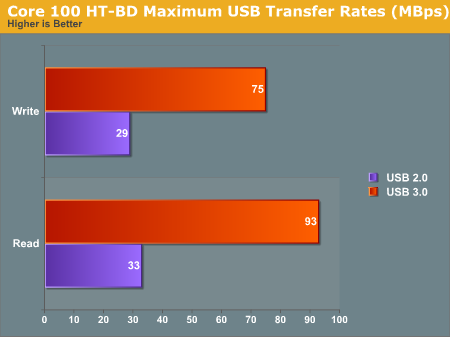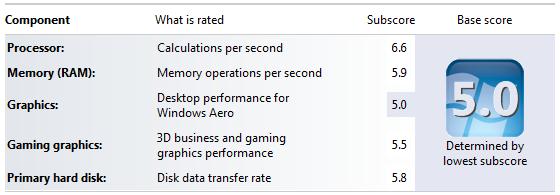ASRock Core 100HT-BD : Bringing HTPCs to the Mainstream Market [UPDATED : Noise Issue]
by Ganesh T S on July 19, 2010 9:34 PM EST- Posted in
- Home Theater
- Arrandale
- ASRock
- Media Streamer
- Core i3
- HTPC
Do the usual benchmarks really provide us with a proper indicator of the worthiness of a HTPC? Is that the performance seen by an average user in real life situations? Such questions often crossed my mind when I looked up the reviews of PCs on various websites. It is almost blasphemous if one were to suggest that the 'Windows Experience Index' is a reflection of what the average user sees. Such a synthetic benchmark might not be a true reflection of the capabilities of the system, but it at least gives an idea to the users as to how much better the system would be compared to the one they currently possess. HTPCs require a different set of performance measurement tests, and we will handle them in the next set of sections. In this, however, we will talk about the general performance metrics in brief.
For readers wanting a lowdown on the core performance aspect (in other words, graphs for various standardized benchmarks) of the motherboard used in this PC, I would suggest reviews from Legion Hardware and Benchmark Reviews. We found nothing in our experiments to dispute their findings. However, one important aspect we would like to cover here is the USB 3.0 performance.
USB 3.0 on the HM55 Chipset
We hooked up OCZ's Enyo 128 GB USB 3.0 external SSD (which has received glowing reviews everywhere with upto 200 MBps read and 190 MBps write speeds) to the front USB 3.0 ports of the Core 100 HT-BD. Contrary to our expectations, we managed to get a maximum of only 93 MBps read and 75 MBps write performance out of the drive. Connecting the same SSD to an USB 2.0 port resulted in a maximum of 33 MBps reads and 29 MBps writes, in line with expectations. We do not get the fabled 10x, but only a 2.7x, improvement over USB 2.0 with the Core 100 HT-BD's USB 3.0 implementation.

A little more analysis revealed that the HM55 chipset does not support PCI-E v2 fully and the bandwidth is limited by the chipset. To get around this limitation, ASRock could have placed a PLX bridge chip on board. We covered this workaround in detail in an earlier piece, but it doesn't make sense for ASRock to implement it in this product. The existing limitation will not be of concern to most users, as SSDs are yet to go mainstream (because of their cost). Most external hard disks with USB 3.0 or eSATA interfaces are inherently limited by the disk-to-buffer transfer rate of around 70 - 90 MBps, and ASRock's USB 3.0 implementation is capable of handling such bandwidth.
Windows Experience Index
A quick glance through the specifications of the system easily reveals the bottleneck affecting the score on the Windows Experience Index. It is none other than Intel's integrated GPU which ends up being the culprit. A screenshot of the Windows Experience Index shows the system chiming in at 5.0. However, we have seen the scores oscillate between 4.4 and 5.2 depending on the graphics driver version, as well as the GPU overclocking status.

Of particular interest is the impressive score received by the processor (6.6), indicating that the performance of this unit would be more than enough for most, if not all, HTPC applications.
DPC Latency Check
Another important criterion for HTPCs is the ability of the system to handle real time streaming of audio and video without dropouts. A handy tool called the DPC Latency Checker helps in analyzing this. This tool was run multiple times in various HTPC scenarios. We did observe red spikes, but disabling the C-states, as well as SpeedStep in the BIOS Advanced CPU configuration helped in alleviating the issue. However, we did not observe any dropouts or playback issues with Blu-Ray or any other media despite the sporadic occurrence of these spikes.
Miscellaneous Performance Indices
Pre-built HTPCs available today are mostly based on the ION chipset, and any comparative evaluation of the benchmark results of this system with ION systems would be grossly unfair for the ION. Both Benchmark Reviews and Legion Hardware compared the Core 100 HT with the ION 330, the 2009 HTPC model from ASRock. Comparing the performance of the Atom to the Core i3 is like comparing apples to oranges, but, for the record, the Core 100 HT system came out better on almost all counts except for the 3D and gaming performance.
On the memory bandwidth side, the Core 100 has more than 2x the performance of the ION 330. CPU performance is around 4 - 5x better. While games appeared to achieve almost similar frame rates on both the Core 100 and the ION 330, 3D performance in applications such as Maya went down by a factor of 2x in favour of the ION 330. Thankfully, applications such as video encoding (a common overnight task for most HTPCs) see a 3.5x performance improvement in the Core 100HT-BD.
In the next section, we will look at the integrated GPU of the Core i3-330M in detail.










107 Comments
View All Comments
Goty - Monday, July 19, 2010 - link
Unfortunately, the lack of even the ability to include a TV tuner in this system kills it for me. If all I am going to do is use it as a Blu-Ray player and DLNA client, I've already got a PS3 that handles both admirably.Allio - Tuesday, July 20, 2010 - link
I agree. I don't understand the niche this system fills - if your needs aren't met by the existing set-top devices, you probably want to do serious gaming on it or use it as a DVR. What exactly does this do better than an ION system, other than be more expensive? Is anyone really encoding video on their HTPCs? That's what my power hungry quad core is for.RamarC - Tuesday, July 20, 2010 - link
ditto. as soon as i saw the external power supply, i immediately started the laptop comparison. it's bigger than a laptop but still has the same limited expansion capability. considering i just got similar a i3 based laptop for a niece going to college for only $550, i can't see why i wouldn't go with the lappy over this mini box.ganeshts - Tuesday, July 20, 2010 - link
RamarC,After having used this unit for 2 weeks in the process of writing the review, I do have to say that the same thought crossed my mind.
However, ASRock does have some compelling points:
1. HTPC centric features such as Instant Boot
2. MCE Remote + I/R Receiver
3. AiWi gaming feature
4. Expansion slot for 2nd hard disk
5. Better audio codec
6. Blu-Ray drive (may also be on the laptop)
Basically, the laptop's monitor & keyboard / trackpad get exchanged for the above features and the unit ends up at the same cost as the notebook.
quiksilvr - Tuesday, July 20, 2010 - link
That's not worth it. I suggest you return it and get a notebook. There are laptops out there with quick launch, an IR receiver, discrete graphics for actual gaming, usb ports for that 2nd hard disk, and expresscard slots for better audio codecs.And on top of all that, you get a screen, a keyboard and a trackpad and mobilitiy.
If this HTPC had discrete graphics and a $500 price tag instead of a $600-$700, then it would be pretty cool. But given that it doesn't, it's not worth it.
ganeshts - Tuesday, July 20, 2010 - link
quiksilvr,This HTPC is supposed to be a companion box for a TV, and as such its 'non-mobile' nature is supposed to lend itself to tasks such as running downloads overnight, and recording TV programs with external tuners and so on and so forth.
For a laptop with the specs you mention, the cost is probably going to be in the $900 - $1000 range. We have done the cost analysis, and it looks like ASRock is just charging a $90 premium (probably lesser if you go with the DVD drive). I believe this will be a compelling investment for people thinking about streamers such as the C-200 from PopCornHour or the Dune and other similar products. They can get an exponential rise in performance and available utilities for a couple of $100s more.
Yes, I agree that notebooks could be a great choice.. provided they fit your usage scenario.
Milleman - Wednesday, July 28, 2010 - link
I use the Zotac MAG Ion w. Intel 330, together with XBMC. Works just great as a streaming device for all my movies on the media server.ganeshts...
You should consider to include XBMC Live (dedicated SBMC Linux installation) in your reviews as well.
ganeshts - Wednesday, July 28, 2010 - link
Milleman,Thanks for your suggestion. XBMC Live doesn't support HD audio bitstreaming, which is fast becoming one of the most important aspects for HTPCs.
I will definitely keep in mind your suggestion for future reviews.
doxxius - Wednesday, July 28, 2010 - link
Well, I use the separate optical audio output jack on the rear which I connect to the audio receiver. Works great for me. But maybe some prefer to have it inside the HDMI cable.ganeshts - Tuesday, July 20, 2010 - link
For HTPC enthusiasts:1. This box can bitstream HD audio to the A/V receiver, while the ION can't.
2. The CPU is much more powerful than the Atom, and the user has the option to let the box run overnight to do tasks (such as downloads and encodes) without running their quad cores. This is a greener alternative.
The opinion that people don't run encodes on their HTPCs is because of the fact that such form factor machines (usually based on Atom) aren't capable enough. With this Arrandale offering, that possibility is getting opened up.
Usage as a DVR is possible using an external USB TV tuner.